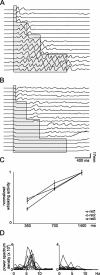Spatial segregation of different modes of movement control in the whisker representation of rat primary motor cortex
- PMID: 15703412
- PMCID: PMC6726007
- DOI: 10.1523/JNEUROSCI.3760-04.2005
Spatial segregation of different modes of movement control in the whisker representation of rat primary motor cortex
Abstract
What is mapped on the surface of the primary motor cortex (M1)? The classic somatotopic map holds true on the level of limb representations. However, on the small scale (at within-limb representations), neither somatotopy nor movement dynamics/kinematics seem to be organizational principles. We investigated the hypothesis that integrated into the body representation of M1 there may be separate representation of different modes of motor control, using different subcortical computations but sharing the same motor periphery. Using awake rats and long intracortical stimulation trains in M1 whisker representation (wM1) revealed that natural-like, rhythmic whisking (normally used for tactile exploration) can be evoked from a posteromedial subregion of wM1. Nonrhythmic whisker retraction, on the other hand, was evoked in an adjacent but more anterolaterally located region within wM1. Evoked whisker retraction was always accompanied by complex movements of the face, suggesting that the respective subregion is able to interact with other representations in specific behavioral contexts. Such associations were absent for evoked rhythmic whisking. The respective subregion rather seemed to activate a downstream central pattern generator, the oscillation frequency of which was dependent on the average evoked cortical activity. Nevertheless, joint stimulation of the two neighboring subregions demonstrated their potency to interact in a functionally useful way. Therefore, we suggest that the cause of cortical separation is the specific drive of subcortical structures needed to generate different types of movements rather than different behavioral contexts in which the movements are performed.
Figures






Similar articles
-
Vibrissa movement elicited by rhythmic electrical microstimulation to motor cortex in the aroused rat mimics exploratory whisking.J Neurophysiol. 2003 Nov;90(5):2950-63. doi: 10.1152/jn.00511.2003. Epub 2003 Aug 6. J Neurophysiol. 2003. PMID: 12904336
-
Rhythmic whisking area (RW) in rat primary motor cortex: an internal monitor of movement-related signals?J Neurosci. 2013 Aug 28;33(35):14193-204. doi: 10.1523/JNEUROSCI.0337-13.2013. J Neurosci. 2013. PMID: 23986253 Free PMC article.
-
Vibrissae motor cortex unit activity during whisking.J Neurophysiol. 2012 Jan;107(2):551-63. doi: 10.1152/jn.01132.2010. Epub 2011 Oct 12. J Neurophysiol. 2012. PMID: 21994257 Free PMC article.
-
Cortical control of whisker movement.Annu Rev Neurosci. 2014;37:183-203. doi: 10.1146/annurev-neuro-062012-170344. Epub 2014 May 9. Annu Rev Neurosci. 2014. PMID: 24821429 Review.
-
Cellular mechanisms of motor control in the vibrissal system.Pflugers Arch. 2006 Dec;453(3):269-81. doi: 10.1007/s00424-006-0101-6. Epub 2006 May 31. Pflugers Arch. 2006. PMID: 16736208 Review.
Cited by
-
Spectral analysis of whisking output via optogenetic modulation of vibrissa cortex in rat.Biomed Opt Express. 2013 Jan 1;4(1):122-33. doi: 10.1364/BOE.4.000122. Epub 2012 Dec 14. Biomed Opt Express. 2013. PMID: 23304652 Free PMC article.
-
Spontaneous Neuronal Activity in Developing Neocortical Networks: From Single Cells to Large-Scale Interactions.Front Neural Circuits. 2016 May 24;10:40. doi: 10.3389/fncir.2016.00040. eCollection 2016. Front Neural Circuits. 2016. PMID: 27252626 Free PMC article. Review.
-
Rat whisker motor cortex is subdivided into sensory-input and motor-output areas.Front Neural Circuits. 2013 Jan 28;7:4. doi: 10.3389/fncir.2013.00004. eCollection 2013. Front Neural Circuits. 2013. PMID: 23372545 Free PMC article.
-
The Cortical States of Wakefulness.Front Syst Neurosci. 2019 Jan 8;12:64. doi: 10.3389/fnsys.2018.00064. eCollection 2018. Front Syst Neurosci. 2019. PMID: 30670952 Free PMC article. Review.
-
Rhythmic arm movements are less affected than discrete ones after a stroke.Exp Brain Res. 2016 Jun;234(6):1403-17. doi: 10.1007/s00221-015-4543-y. Epub 2016 Jan 9. Exp Brain Res. 2016. PMID: 26749181
References
-
- Berg RW, Kleinfeld D (2003a) Rhythmic whisking by rat: retraction as well as protraction of the vibrissae is under active muscular control. J Neurophysiol 89: 104-117. - PubMed
-
- Berg RW, Kleinfeld D (2003b) Vibrissa movement elicited by rhythmic electrical microstimulation to motor cortex in the aroused rat mimics exploratory whisking. J Neurophysiol 90: 2950-2963. - PubMed
-
- Bermejo R, Zeigler HP (2000) “Real-time” monitoring of vibrissa contacts during rodent whisking. Somatosens Mot Res 17: 373-377. - PubMed
Publication types
MeSH terms
LinkOut - more resources
Full Text Sources
Other Literature Sources
